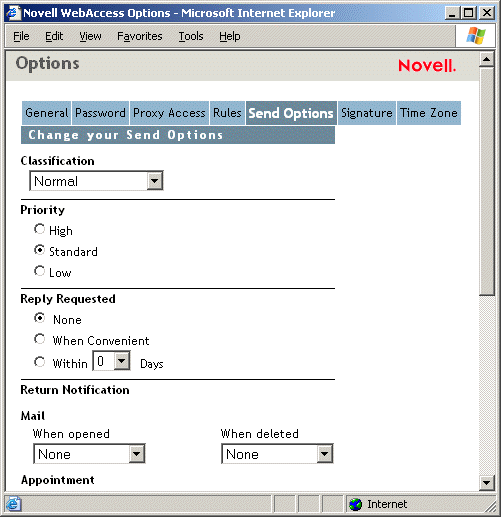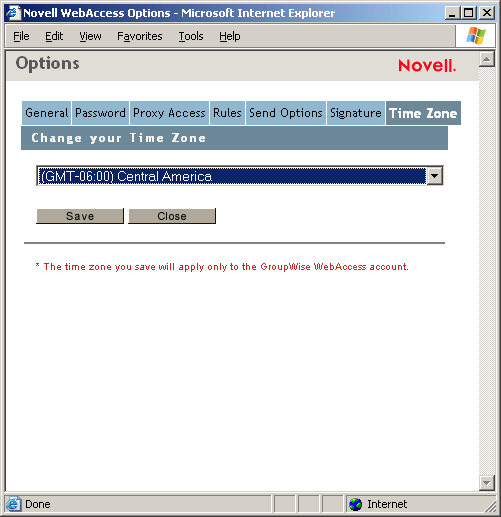Modifying WebAccess Options
You can use GroupWise WebAccess to modify options to change your password, change your send options, change your time zone, create rules, and more.
This section contains the following topics:
- Changing Your GroupWise Password
- Specifying Send Options
- Setting the Default Number of Messages to Display
- Changing Your Time Zone
- Automatically Adding A Signature to Items You Send
- Using Rules
Changing Your GroupWise Password
If your system administrator has turned on LDAP authentication, your LDAP password is used instead of your GroupWise password to access GroupWise WebAccess. If LDAP authentication is turned on, the following procedure changes your LDAP password.
-
From the GroupWise WebAccess main window, click the Options icon.
-
Click Password.
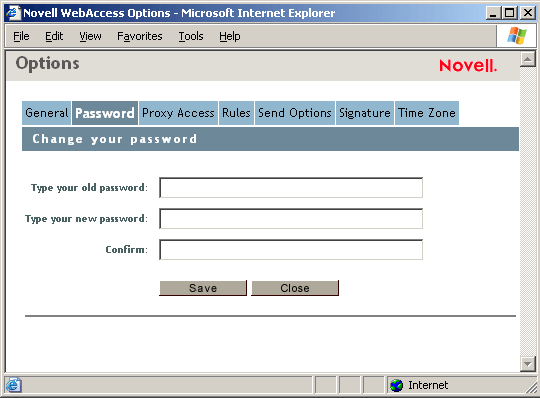
-
Type your old password.
-
Type your new password, then retype the new password to confirm it.
Remember that your password is case-sensitive.
-
Click OK.
When you change your password in GroupWise WebAccess, you change it for your GroupWise Mailbox. That means that you always use the same password to log in to your GroupWise Mailbox whether you are using GroupWise WebAccess or another version of the GroupWise client.
Specifying Send Options
You can specify send options for different types of items (mail, appointment, task, note, phone message) you send, and you can specify global send options that affect every item you send. Send options include the following:
Classification
A classification is a security setting that lets the recipient know if the item is confidential, top secret, and so forth. This information appears at the top of the item. A classification does not provide any encryption or additional security. It is meant to alert the recipient to the relative sensitivity of the item.
Priority
Recipients can see the priority of an item by looking at the color of the icon next to the item in the Item List. High priority items are red, normal priority items are white, and low priority items are gray.
Reply Requested
When you request a reply to an item, the recipient of the item sees next to the item in the Item List. If you select When Convenient, "Reply Requested: When convenient" appears at the top of the item. If you select Within x Days, "Reply Requested: By xx/xx/xx" appears at the top of the item. If the recipient attempts to delete an item without replying, he or she is reminded that the item requested a reply. (The recipient can still delete the item without replying.)
Return Notification
Return notification lets you know information such as when the recipient opens or deletes an item, declines an appointment, or completes a task. If you select to receive Notify or Notify and Mail, this will only apply when you are using the GroupWise client for Windows. Receiving notifications through Notify is not supported in GroupWise WebAccess.
Requesting a Reply for All Items You Send
-
From the GroupWise WebAccess main window, click the Options icon.
-
Click Send Options.
-
Under Reply Requested, specify when you want to receive a reply.
The recipient sees
 next to the message. If you select When Convenient, "Reply Requested: When convenient" appears at the top of the message. If you select Within x Days, "Reply Requested: By xx/xx/xx" appears at the top of the message.
next to the message. If you select When Convenient, "Reply Requested: When convenient" appears at the top of the message. If you select Within x Days, "Reply Requested: By xx/xx/xx" appears at the top of the message. -
Click Save, then click Close.
Getting a Return Receipt for All Items You Send
-
From the GroupWise WebAccess main window, click the Options icon.
-
Click Send Options.
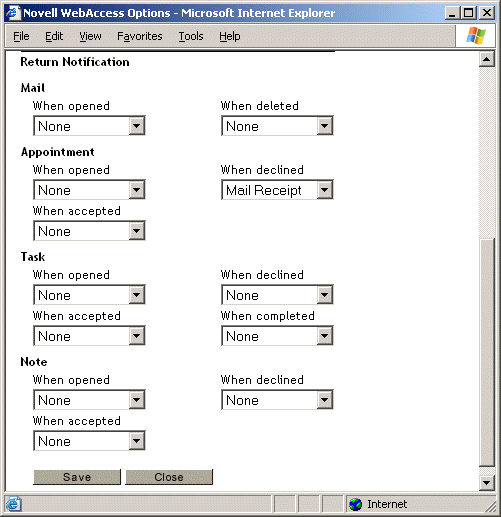
-
In the Return Notification group box, specify the type of return receipt you want.
If you select to receive Notify or Notify and Mail, this will only apply when you are using the GroupWise client for Windows. Receiving notifications through Notify is not supported in GroupWise WebAccess.
-
Click Save, then click Close.
Changing Your Time Zone
To ensure that dates and times are correct in messages, appointments, and other time-relevant information, GroupWise WebAccess must know the time zone in which you are located. GroupWise WebAccess automatically adjusts the time for appointments sent between people in different time zones. For example, if you are located in New York and schedule a conference call with people in Los Angeles for 4:00 p.m. your time, the appointment received by the Los Angeles recipients will show the conference call at 1:00 p.m. their time.
By default, GroupWise WebAccess uses the time zone established for your GroupWise post office. However, if you are using GroupWise WebAccess in a time zone other than your post office's time zone, you should change your time zone setting. For example, if your post office is located in New York but you are working in Chicago, you would need to change your time zone setting from Eastern Time to Central Time.
The GroupWise WebAccess time zone setting applies only to GroupWise WebAccess. If you have access to the Windows version of the GroupWise client, that client will use the time zone configured through the Windows operating system, not the time zone you set in GroupWise WebAccess.
Automatically Adding A Signature to Items You Send
You can create an electronic signature that contains your name, title, phone number, and so forth. You can then choose to add the signature automatically to items you send or to prompt you before adding it.
-
From the GroupWise WebAccess main window, click the Options icon.
-
Click Signature.
-
Click Activate Signature.
-
Type your signature text in the box.
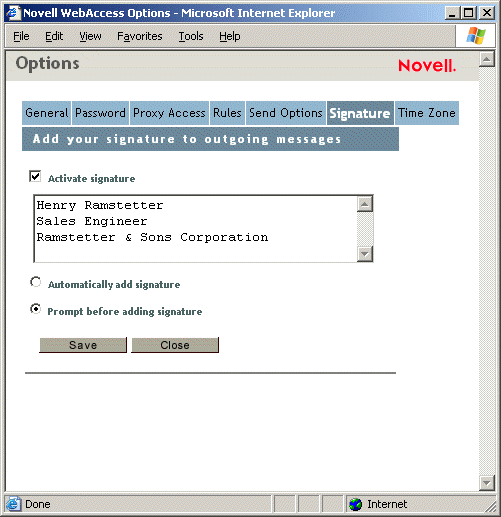
-
Click Automatically Add Signature to have GroupWise WebAccess add the signature when you send the item.
or
Click Prompt Before Adding Signature to have GroupWise WebAccess prompt you before adding the signature when you send the item.
-
Click Save.
When you create a signature, GroupWise WebAccess stores it in your GroupWise Mailbox at your post office. Whether you log in to your Mailbox through GroupWise WebAccess or another version of the GroupWise client, you always have the same signature.
Using Rules
You can use rules to define actions that you want to be performed on items you receive. For example, you can forward or reply to messages or move messages to folders. Rules can help you organize your Mailbox, automate your Mailbox while you are away, or delete unwanted items.
Requirements for Creating a Rule
When you create a rule, you must do the following:
- Select the type of action you want performed. The available actions are: forward, reply to, delete, move to a folder, and vacation. Vacation is simply a predefined type of reply.
- Name the rule. By naming the rules, you can have more than one rule that uses the same action.
- Define any optional conditions. For example, you might want to move all items you receive from your supervisor to a specific folder. You can define a condition so that only messages with your supervisor's name on the From line are moved to the folder. All other items will remain in your main Mailbox folder.
- Fill in the information required to carry out the action. For example, you may need to specify the folder where you want to move the messages.
- Save the rule.
Using Rules Created with Another GroupWise Client
Rules are stored in your GroupWise Mailbox at your post office. Because of this, rules you've defined in other versions of the GroupWise client will also appear in the Rules list and will apply when you use GroupWise WebAccess.
Editing Rules
You can edit any rules you create in GroupWise WebAccess. If you've created rules using another version of the GroupWise client, you will be able to edit those rules provided they do not contain more capabilities than GroupWise WebAccess allows you to set. For example, the Windows version of the GroupWise client lets you create rules to apply to items you are sending. Because the Rules feature in GroupWise WebAccess does not include this capability, you would not be able to edit that rule.
Creating a Rule
-
From the GroupWise WebAccess main window, click the Options icon.
-
Click Rules.
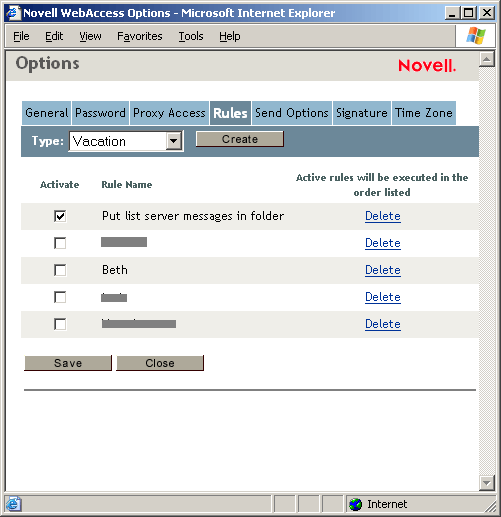
-
Select the type of rule you want to create:
Delete: Moves an item to the Trash. You can apply the rule to all new items or only new items that meet the criteria you establish.
Forward: Forwards an item to the recipients you specify. You can apply the rule to all new items or only new items that meet the criteria you establish.
Move to Folder: Moves an item to the folder you specify. You can apply the rule to all new items or to only new items that meet the criteria you establish.
Reply: Generates a reply to an item. The reply can go to the sender of the item only (Reply to Sender) or to all recipients of the item (Reply All). You can apply the rule to all new items or only new items that meet the criteria you establish.
Vacation: Generates a reply to all new items you receive. The reply goes to the sender of the item only (Reply to Sender), not to all recipients of the item (Reply All).
-
Click Create to display the Create Rule form.
-
Type the name you want to use for the rule. Names can include any characters, including spaces.
-
If desired, define an optional condition to limit the items that are affected by the rule. If you do not define an optional condition, the rule will be applied to all new items you receive.
You cannot define an optional condition for the Vacation rule. The Vacation rule is applied to all items.
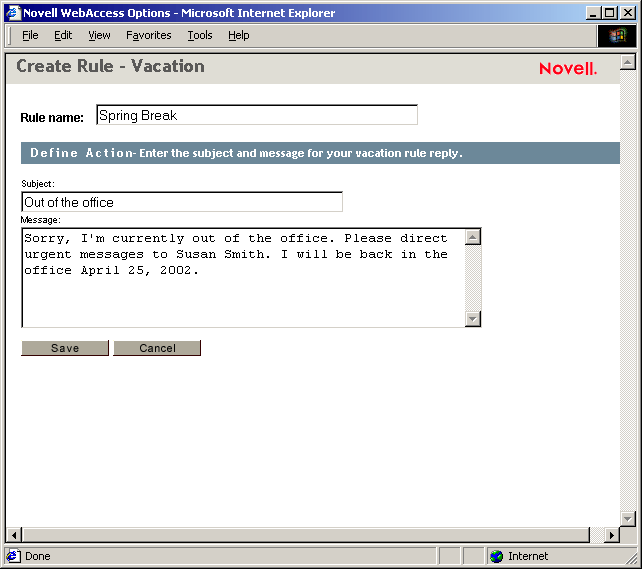
-
Define the actions that you want performed when the rule is applied.
The actions vary depending on the type of rule you are creating. For example, when creating a rule to reply to items, you select whether you want to reply to the sender only or the sender and all recipients. When moving an item to a folder, you select the destination folder.
-
Click Save to save the rule to the Rules list.
-
By default, the rule is automatically activated. If you don't want the rule to be active at this time, deselect the rule's Activate box, then click Save.
or
To keep the rule active, click Close.
When you create a rule, GroupWise WebAccess stores it in your GroupWise Mailbox at your post office. Whether you log in to your Mailbox through GroupWise WebAccess or another version of the GroupWise client, you always have the same rules.
Activating or Deactivating Rules
By default, when you save a rule that you've just created, it is automatically activated. GroupWise WebAccess will execute the rule for any new items you receive. It will not execute the rule for any items you have already received.
Forwarding Your E-mail to a Different Account
This is an example of a rule that automatically forwards new items entereing your mailbox to a different e-mail account.
-
From the Create Rule Form, select the Forward rule, then click the Create button.
-
Type a name for the rule in the Rule name field.
-
From the first condition field, select To. This tells the rule to check the To: line in each incoming item.
-
From the second condition field, select Matches. This tells the rule that the text in the incoming item's To: line must match the text you type in the next condition field.
-
In the last condition field, type the complete e-mail address of the account from which you want to move the e-item. For example: msmith@megadynasoft.com.
-
Define the actions to be be taken by the rule. In the first action field, type the complete e-mail address of the account to which you want to send the item. Include other addresses to which you might want to courtesy copy or blind copy.
-
Type a subject to the e-mail indicating that it is moving from the old account to the new. For example: From msmith@megadynasoft.com to marys@promegadynacorp.com.
-
Use the message field to include any other notes or instructions for the reader at the new account.
-
Click the Save button.
